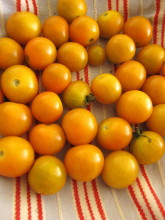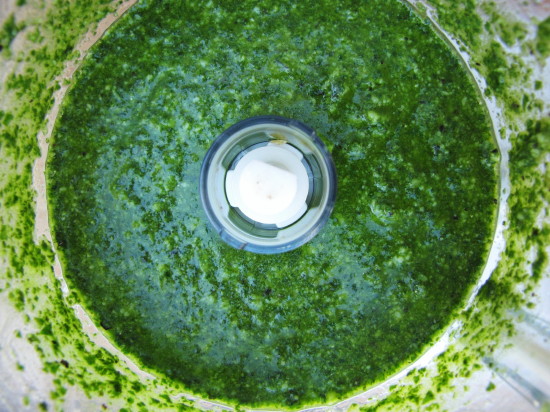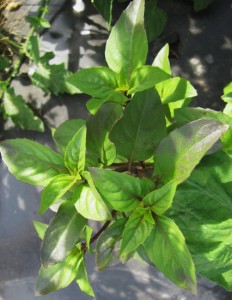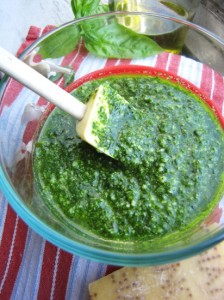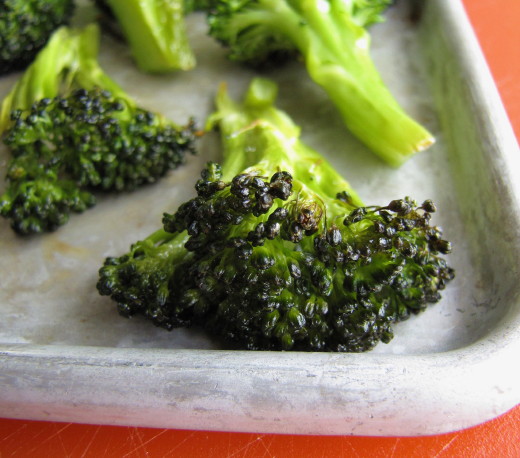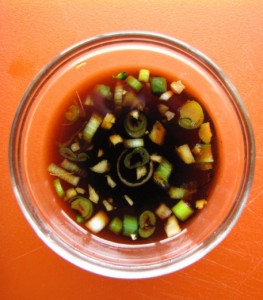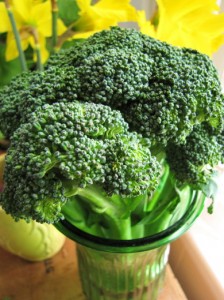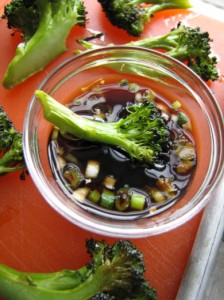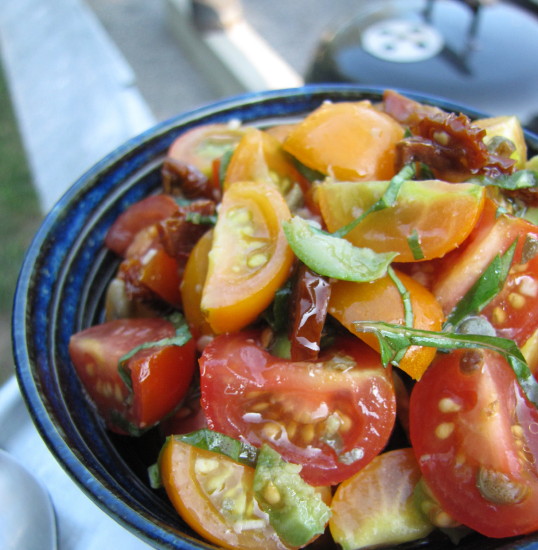 There is a scene in the Nutcracker ballet where the evil Mouse king dances with his mouse-followers beneath the giant Christmas tree at midnight. When I look at our tomatoes every morning, I envision something like this having gone on the night before. There are tomatoes strewn everywhere, little bites taken out of just-ripening cherry tomatoes, and big bites taken out of bigger tomatoes. Mr. Mouse or Mr. Rat is, apparently, also joined by his close personal friends, Mr. and Mrs. Hornworm (and all their prodigy), and a flock (or several flocks) of sparrows, all of whom enjoy illicit tomato-tastings under the light of the moon. It’s not hard to imagine how fun this is—we planted our tomatoes way too close together, so the two big rows form sort of a hedge. It’s really more like a forrest, and even I can appreciate the magical wonder of that leafy canopy when I am crawling around on my hands and knees in there looking for signs of invaders. It’s like a cool fort, stocked with candy.
There is a scene in the Nutcracker ballet where the evil Mouse king dances with his mouse-followers beneath the giant Christmas tree at midnight. When I look at our tomatoes every morning, I envision something like this having gone on the night before. There are tomatoes strewn everywhere, little bites taken out of just-ripening cherry tomatoes, and big bites taken out of bigger tomatoes. Mr. Mouse or Mr. Rat is, apparently, also joined by his close personal friends, Mr. and Mrs. Hornworm (and all their prodigy), and a flock (or several flocks) of sparrows, all of whom enjoy illicit tomato-tastings under the light of the moon. It’s not hard to imagine how fun this is—we planted our tomatoes way too close together, so the two big rows form sort of a hedge. It’s really more like a forrest, and even I can appreciate the magical wonder of that leafy canopy when I am crawling around on my hands and knees in there looking for signs of invaders. It’s like a cool fort, stocked with candy.
Today Roy bought an inflatable owl. A big one. And stuck it right on top of one of the tomato stakes.
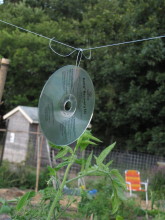
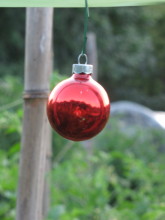 Last night, we strung monofilament line between the bamboo stakes, and hung shiny CDs and yellow streamers from it. I also hung a few red Christmas ball ornaments around, which are supposed to lure birds into pecking at them instead of tomatoes (and thereby discourage further pecking).
Last night, we strung monofilament line between the bamboo stakes, and hung shiny CDs and yellow streamers from it. I also hung a few red Christmas ball ornaments around, which are supposed to lure birds into pecking at them instead of tomatoes (and thereby discourage further pecking).
Discouraging the rats and birds might work (will keep you posted). But we’ve yet to capture a hornworm. Normally, if you look hard enough, you can spot these big, ugly (and I mean UGLY) caterpillars, but we’ve looked and looked and haven’t seen one yet.
All this is incredibly frustrating, as we have 40 tomato plants, hundreds (maybe thousands because of the prolific little Sun Golds) of tomatoes ripening, and so many visitors (including POTUS, of course) coming to the Island in August, that we are looking at missing our best opportunity to make a little bit of real money at the farm stand.
In the short term, I’ve taken the advice of several farmers and started harvesting tomatoes that are just starting to blush. Apparently once they’ve started coloring, the quality will not be affected by ripening on a windowsill. (This doesn’t work with rock hard, dark green tomatoes that haven’t begun the ripening process.) This is hardly ideal, but right now, leaving anything with any color on the vine seems to be an automatic death sentence for the tomato.
Roy remembered that putting tomatoes in a bag with an apple will help ripen them, too, so we tried that with a batch of Sun Golds. We put them in a shallow bowl with a ripe apple cut into pieces and covered the whole thing with an upside down stainless steel bowl. In two days, most of the tomatoes had turned yellow and were heading for the even deeper orange color of a perfectly ripe Sun Gold. They tasted good, but some were still a tiny bit green on the inside. They’re best when they’re orange all the way through.
Nevertheless, we celebrated this small ripening feat by making one of my favorite easy summer cherry tomato concoctions last night. It’s a versatile dressing, kind of a loose salsa, that’s delicious over grilled vegetables, grilled meats, and even grilled bread. We had it atop a grilled sirloin and some grilled zucchini from our garden.
The version I made last night (below) is a variation on a recipe in Fast, Fresh & Green which I drape over a roasted pepper that is lightly stuffed with warm goat cheese. It’s a showcase for your tiniest, tastiest tomatoes, but it gets a depth of flavor from a bit of sundried tomato mixed in, too. The dressing has a Spanish-y feel, with a few minced capers, sherry vinegar, garlic, and sometimes a few sliced olives mixed in. I used mint and basil both last night, but any fresh herb would work. Fresh ginger is also a natural with tomatoes, so you could vary the dressing to include some ginger, too. Any way you make it, this no-cook versatile recipe is a fast flavor boost for a weeknight supper (or a weekend party). Of course, it’s a whole lot more satisfying with your own vine-ripened tomatoes, but take what you can get!
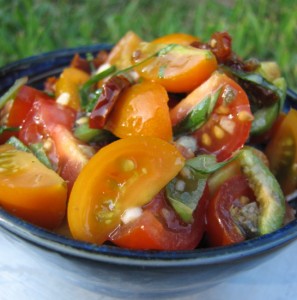 Summer Cherry Tomato Dressing, V2
Summer Cherry Tomato Dressing, V2
Please don’t make this with those honking cherry tomatoes from the grocery store. They won’t taste great and will be too cumbersome for a salsa-like dressing, even if they’re quartered. Stick with small cherries, Sun Golds, Red Pears, and other fun little tomatoes. Be sure to get a brand of sundried tomatoes that isn’t marinated too heavily with overbearing dried herbs (I’ve had this experience—sundried tomatoes vary in flavor and quality a lot) as they might adversely affect the flavor of your dressing.
____________________________________________________
8 ounces small cherry or other tiny tomatoes, halved or quartered depending on size
3 tablespoons extra-virgin olive oil
2 tablespoons very finely sliced, drained, oil-packed sundried tomatoes
1 tablespoon finely sliced basil and/or mint leaves
2 teaspoons drained capers, very lightly chopped
4 green olives, pitted and sliced (optional)
1 tablespoon sherry vinegar
1 teaspoon orange juice
½ teaspoon minced garlic
¼ teaspoon teaspoon kosher salt
____________________________________________________
Combine all of the ingredients in a small bowl and stir gently to combine. Let sit for 10 to 15 minutes (or up to 30 minutes) to let the flavors mingle and to let the tomatoes marinate a bit. Stir gently again before serving.
Yields about 1 ¼ cups, enough to dress up four dinners


